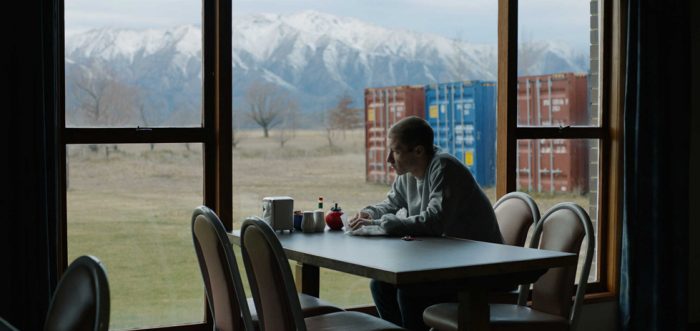
From The Quiet Earth and Sleeping Dogs to In My Father’s Den and Out Of The Blue, the New Zealand “man alone” film is a genre unto itself. Having now reached the point of parody (knowing in Hunt For The Wilderpeople, less knowing in far too many short films), it’s fair to approach any new entrant in this field with a healthy dose of skepticism.
Ten years in the making, Dustin Feneley’s ambitious crowd-funded debut feature Stray distinguishes itself immediately from its brethren with its lack of score, striking static framing, and an austerity rarely found on these shores, more common to post-Haneke European art cinema; the first — and for quite some time, only — dialogue scene is staged in a tableau that recalls Steve McQueen’s Hunger. These stark choices immediately double as a litmus test for the audience, as the slow pace and stillness — initially difficult to read as tension or release — will engage some and bore others. But it sets the rhythm and intent of this powerfully controlled film effectively.
Stray’s opening passage follows Jack (Kieran Charnock), a young hard man at the end of a three-year jail term, attempting to re-integrate into an indifferent society, one where his family members are distant and disinterested and job prospects are poor. His soft-spoken manner is difficult to reconcile with the unspecified violent crime he’s committed, and Charnock wisely and convincingly underplays his role, leaving it unclear what rage remains and just how deeply it might be buried as he heads across the Cook Strait, to a remote cabin and an uncertain future. Throughout this journey, Feneley’s concerns are never about advancing story but about observing moments, situating Jack in a rugged terrain, and letting us observe the rituals and behaviour of a man who is alone and quiet but clearly not at peace.
Perhaps a half-hour in — certainly at the point one might become exasperated with the lack of forward plot development — the story suddenly shifts to a mental health respite facility, where the brittle Grace (Arta Dobroshi, Lorna’s Silence) is ending her stay. As with Jack, she exits an institution and enters an uncertain future without support. Abandoned by family, and traveling on her own, she makes her way through unoccupied rural residences, at one point wandering through a particularly grand house as if it’s an alien museum, making the distance between domesticity and her place in it seeming completely intractable.
It’s a foregone conclusion that these two alienated loners will cross paths. With the stark aesthetic and unsentimental tone, as well as a rifle on the scene, one can be forgiven for expecting that things won’t end well. But Feneley’s no provocateur, and has bigger concerns on his mind than shocking the audience. Through watching Jack and Grace — a name, perhaps, just slightly too on the nose — negotiate a relationship as unique and challenging as they are, Feneley’s dramatic concerns become clear. Can we change? Can we heal? Can we leave behind that which scars us?
While not an apolitical film — an implicit critique of the failures in New Zealand’s social net hangs over the entire proceedings — Feneley never lets social commentary overpower his narrative, constantly returning to the internal struggle, and never romanticising the damage his protagonists suffer from. Through patient observation of intimate moments — and an increasingly mobile camera, paralleling the character’s growth as they begin to interact more and more with locals and face their past — Stray finds its way to an ending so subtle, it may take a moment to even recognise the significance of what’s happened. (Those who have checked out earlier may miss it entirely.)
Most of the accolades for Stray will go to Charnock’s wound-up and wounded performance, to DoP Ari Wegner for photographing interiors as strikingly as the South Island mountains that play the backdrop, and to Feneley himself, for capturing moments of striking realism in such an aestheticized manner. (Jack’s visit to a local bingo game, a scene where nothing much happens, has stuck with me for weeks because of its fulsome local colour and lack of condescension.) But worthy of singling out is the contribution of sound designer Dick Reade, whose attention to detail makes the lengthy dialogue-free passages of the film — don’t call them silences, as they’re anything but — sing. It’s a quiet song, but if you listen closely, it’s captivating.
